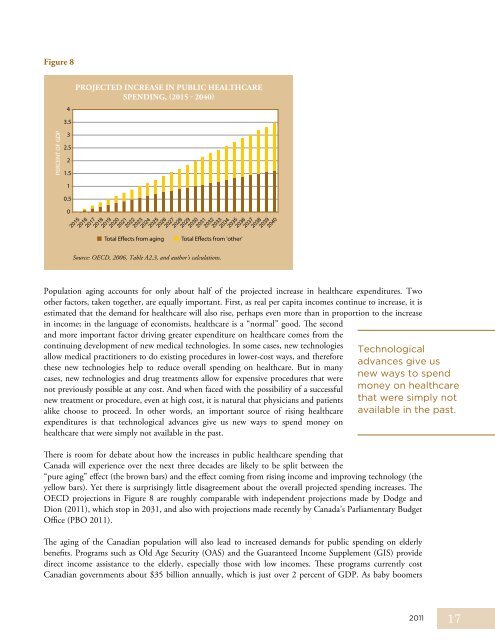Christopher Ragan, "Canada's Looming Fiscal Squeeze," November
Christopher Ragan, "Canada's Looming Fiscal Squeeze," November
Christopher Ragan, "Canada's Looming Fiscal Squeeze," November
You also want an ePaper? Increase the reach of your titles
YUMPU automatically turns print PDFs into web optimized ePapers that Google loves.
Figure 8<br />
PERCENT OF GDP<br />
4<br />
3.5<br />
3<br />
2.5<br />
2<br />
1.5<br />
1<br />
0.5<br />
0<br />
PRoJECTED INCREASE IN PuBLIC HEALTHCARE<br />
SPENDING, (2015 - 2040)<br />
2015<br />
2016<br />
2017<br />
2018<br />
2019<br />
2020<br />
2021<br />
2022<br />
2023<br />
2024<br />
2025<br />
2026<br />
2027<br />
2028<br />
2029<br />
2030<br />
2031<br />
2032<br />
2033<br />
2034<br />
2035<br />
2036<br />
2037<br />
2038<br />
2039<br />
2040<br />
Total Effects from aging Total Effects from 'other'<br />
Source: OECD, 2006, Table A2.3, and author’s calculations.<br />
Population aging accounts for only about half of the projected increase in healthcare expenditures. Two<br />
other factors, taken together, are equally important. First, as real per capita incomes continue to increase, it is<br />
estimated that the demand for healthcare will also rise, perhaps even more than in proportion to the increase<br />
in income; in the language of economists, healthcare is a “normal” good. The second<br />
and more important factor driving greater expenditure on healthcare comes from the<br />
continuing development of new medical technologies. In some cases, new technologies<br />
allow medical practitioners to do existing procedures in lower-cost ways, and therefore<br />
these new technologies help to reduce overall spending on healthcare. but in many<br />
cases, new technologies and drug treatments allow for expensive procedures that were<br />
not previously possible at any cost. And when faced with the possibility of a successful<br />
new treatment or procedure, even at high cost, it is natural that physicians and patients<br />
alike choose to proceed. In other words, an important source of rising healthcare<br />
expenditures is that technological advances give us new ways to spend money on<br />
healthcare that were simply not available in the past.<br />
Technological<br />
advances give us<br />
new ways to spend<br />
money on healthcare<br />
that were simply not<br />
available in the past.<br />
There is room for debate about how the increases in public healthcare spending that<br />
Canada will experience over the next three decades are likely to be split between the<br />
“pure aging” effect (the brown bars) and the effect coming from rising income and improving technology (the<br />
yellow bars). Yet there is surprisingly little disagreement about the overall projected spending increases. The<br />
oeCD projections in Figure 8 are roughly comparable with independent projections made by Dodge and<br />
Dion (2011), which stop in 2031, and also with projections made recently by Canada’s Parliamentary budget<br />
office (Pbo 2011).<br />
The aging of the Canadian population will also lead to increased demands for public spending on elderly<br />
benefits. Programs such as old Age Security (oAS) and the Guaranteed Income Supplement (GIS) provide<br />
direct income assistance to the elderly, especially those with low incomes. These programs currently cost<br />
Canadian governments about $35 billion annually, which is just over 2 percent of GDP. As baby boomers<br />
2011<br />
17





